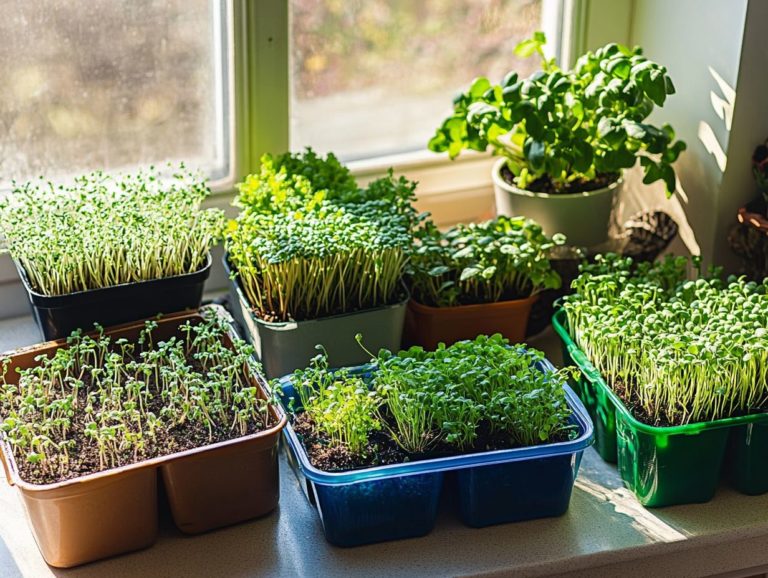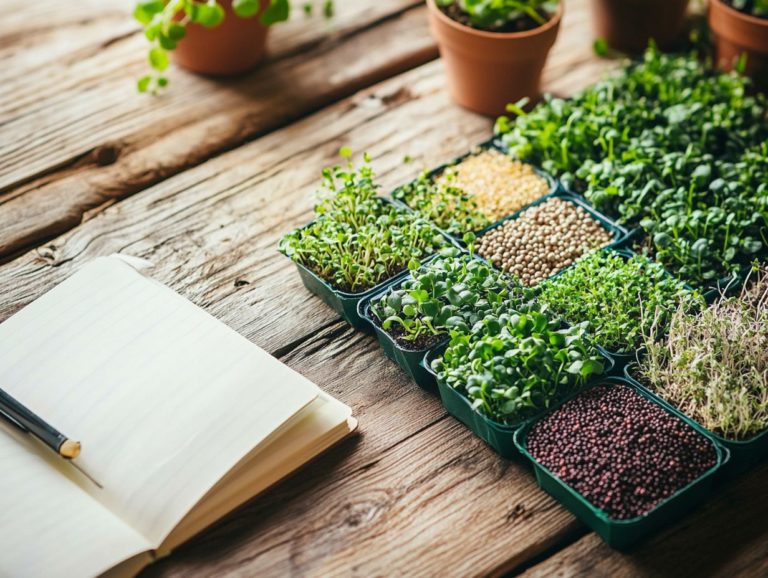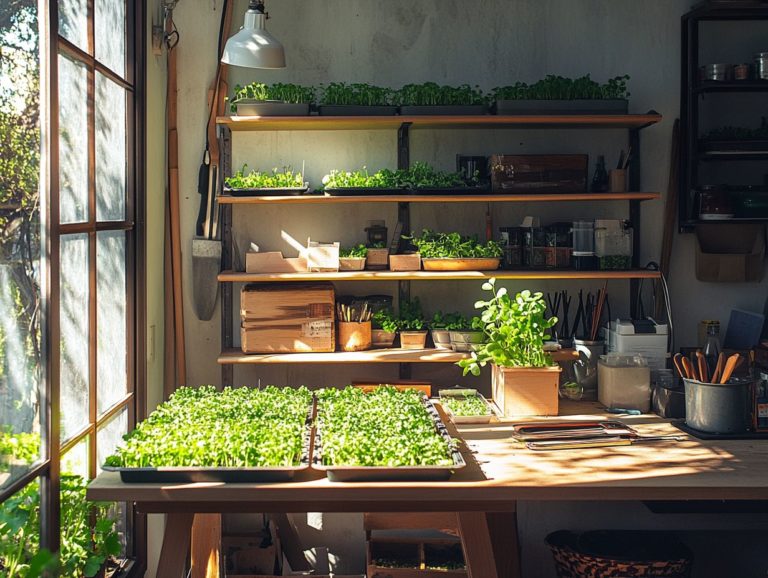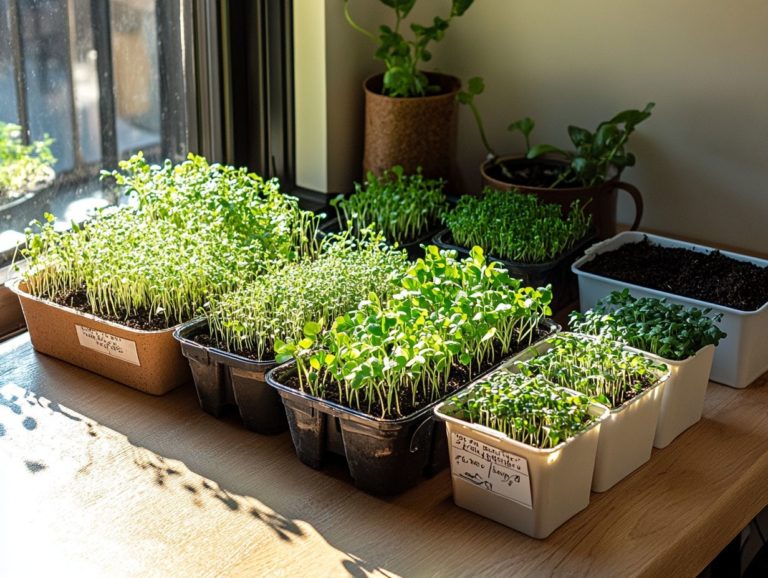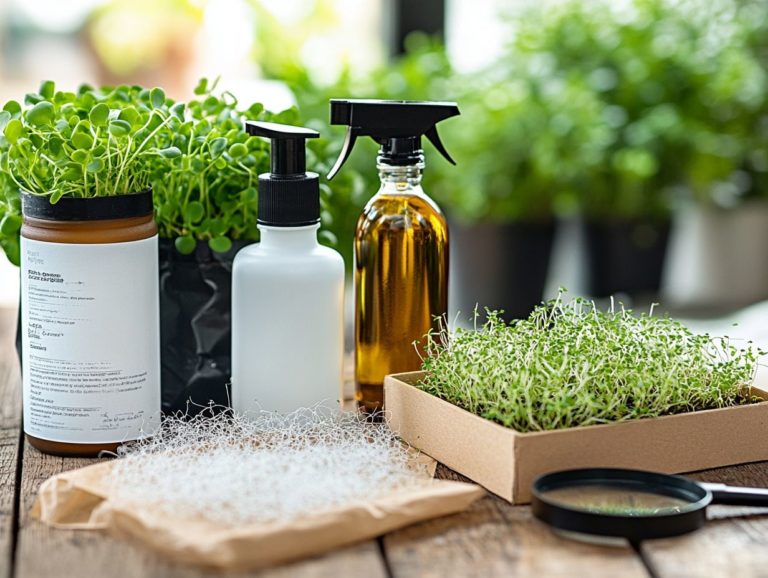Best Practices for Microgreen Harvesting Tools
Microgreens have surged in popularity in the culinary world. They are known for their vibrant flavors and impressive nutritional benefits.
To get the best results from these delicate plants, you need the right tools for growing microgreens. This article highlights the importance of using suitable harvesting tools, from scissors to microgreen trays, to boost your efficiency and harvest quality.
You will learn essential cutting and handling techniques. We’ll also share tips to keep your kitchen tools in great shape.
Contents
- Key Takeaways:
- Benefits of Using Proper Harvesting Tools
- Types of Microgreen Harvesting Tools
- Choosing the Right Tool for Your Needs
- Proper Techniques for Using Harvesting Tools
- Maintaining and Cleaning Your Harvesting Tools
- Frequently Asked Questions
- What are some best practices for using microgreen harvesting tools?
- Why is cleanliness crucial in microgreen harvesting?
- How often should I sanitize my microgreen harvesting tools?
- What are some ways to gently handle microgreens while harvesting?
- Can I reuse the same harvesting tools for different types of microgreens?
- Are there any alternative tools that can be used for harvesting microgreens?
Key Takeaways:
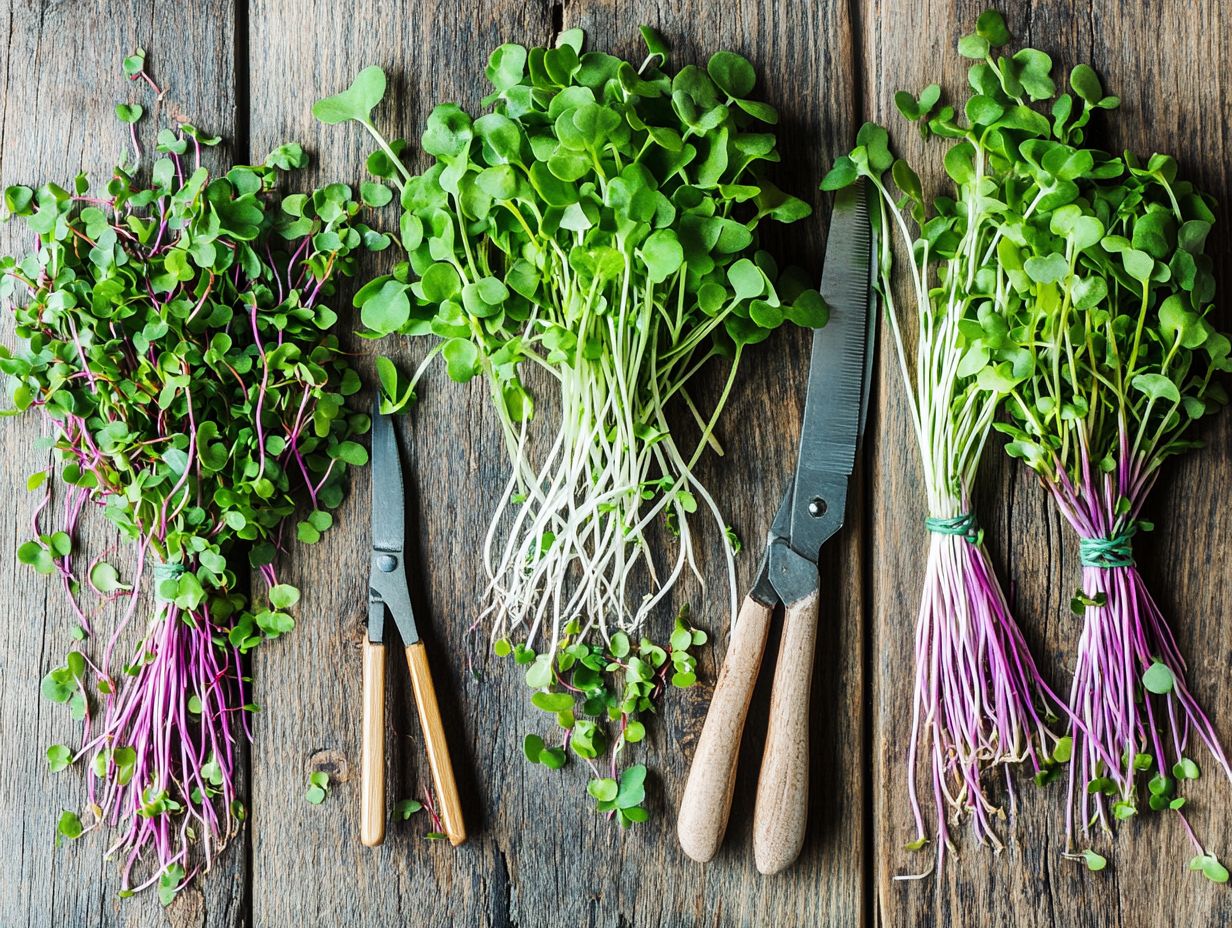
What are Microgreens?
Microgreens are tiny edible plants that you can harvest early in their growth. They are packed with flavor, color, and essential nutrients.
Common varieties include pea shoots, radish microgreens, and sunflower microgreens, each adding unique taste and health benefits. They can be easily grown at home, whether in a garden or on a windowsill.
With the right seeds and growing medium, you can cultivate these nutrient-dense plants and enhance your culinary dishes. Their compact size and nutrient profile contribute to their growing popularity.
The journey of microgreens starts with germination, where seeds sprout and develop roots. These plants absorb sunlight, leading to vibrant leaves ready for harvest within two to three weeks.
Rich in vitamins A, C, E, and K, along with essential minerals, microgreens support immunity and heart health. They offer endless culinary possibilities, from garnishing salads to elevating soups and sandwiches.
Join the thriving community around microgreens filled with tips for optimal growing conditions. Share a love for sustainable gardening and healthy eating.
Benefits of Using Proper Harvesting Tools
Using the right harvesting tools is key to improving efficiency and the quality of your microgreens. With the right tools, you ll find tasks become quicker and easier while minimizing damage to your greens.
This not only leads to healthier vegetables but also enhances your gardening experience. By investing in high-quality tools and avoiding common mistakes in microgreen harvesting, managing your microgreen growth becomes effortless, giving you fresh, home-grown produce.
Efficiency and Quality Improvement
Your efficiency and quality in harvesting microgreens depend on the tools you choose. Selecting the right harvesting tools allows for quicker and more precise cutting, preserving the delicate integrity of those microgreens. This enhances your gardening experience and maximizes the nutritional value of your harvest. As you learn to use these tools, you ll notice a significant increase in the quality of your home-grown vegetables.
For instance, specialized scissors designed for microgreens provide a clean cut that minimizes damage, ensuring these nutrient-packed greens retain their flavor and freshness. A sharp knife or harvesting blade boosts your efficiency, helping you reach that optimal harvest time without compromising quality. After harvesting, it’s important to know the best methods for storing microgreens to maintain their quality.
Incorporating tools like moisture meters helps you monitor soil conditions accurately, supporting better plant management. By using these advanced implements, you unlock a more rewarding gardening experience and enjoy the benefits of thriving plants and healthier produce.
Types of Microgreen Harvesting Tools
Understanding the different types of microgreen harvesting tools can significantly improve your gardening experience. Essential tools like scissors offer the precision needed for delicate microgreens, while harvesting knives ensure a clean cut that reduces damage to the plants.
Investing in harvesting trays is invaluable for efficiently collecting and storing your yield. Using the right gardening supplies not only streamlines the harvesting process but also promotes the longevity and health of your plants, creating optimal growing conditions.
Scissors

Scissors are among the most essential tools for harvesting microgreens, celebrated for their ability to make clean cuts without harming the plants. The precision they offer ensures that each microgreen is harvested at its peak growth stage, preserving its nutrient density. They re lightweight and user-friendly, making them perfect for snug spaces like your windowsill garden.
With scissors in hand, you can make quick snips, minimizing the time spent in your garden while reducing stress on the remaining plants. Learning the right cutting techniques, such as using a gentle wrist motion and angling the blades correctly, can significantly enhance your harvesting efficiency. For those interested in microgreens, understanding the timing of microgreen harvest promotes healthier regrowth and allows for repeated harvesting cycles without compromising your plants’ health.
Compared to traditional tools, scissors offer a more deliberate approach, ensuring each microgreen is cut just above the soil line. For more insights on this process, consider understanding microgreen harvest timing. This maximizes the potential for future growth while maintaining the aesthetic appeal of your garden.
Knives
Knives designed for harvesting microgreens are essential for anyone looking to boost efficiency and speed during the harvesting process. Their sharp blades enable swift and clean cuts, reducing stress on the microgreens and helping them retain their freshness and nutritional value. Using these knives correctly can help you harvest more microgreens efficiently, especially when working with larger trays in your indoor gardening projects.
Understanding the various types of harvesting knives is key to effective plant management and maximizing microgreens growth. For example, a serrated blade glides through delicate stems without crushing them, while a straight edge excels at slicing swiftly through tougher varieties. Additionally, following the best practices for watering microgreens can enhance your growth results. Ergonomic handles are designed to fit comfortably in your hand, reducing strain during use.
To maintain hygiene, it’s crucial to clean the blades after each use, particularly to prevent cross-contamination. A simple wash with soapy water followed by thorough drying can help prevent cross-contamination and extend the lifespan of your tools. Regularly sharpening the blades ensures peak performance, making these knives a critical part of your harvesting toolkit.
Harvesting Trays
Harvesting trays are critical tools in your gardening arsenal. They are designed to streamline the collection and organization of microgreens after they’ve been cut.
These trays create a stable environment for your freshly harvested greens, preserving their quality and nutrient value until they make their way to your kitchen. Choosing the appropriate size and design of harvesting trays can significantly enhance your efficiency during the harvesting process.
You’ll find a variety of tray designs available, ranging from shallow to deep. Each is tailored for specific types of microgreens.
The materials used whether plastic, bamboo, or metal offer distinct advantages, such as durability or eco-friendliness. Some materials can restrict air circulation, so be mindful when selecting trays. Choose trays with holes that allow air to circulate.
Prepare your trays properly to boost their effectiveness! This includes thorough cleaning and occasional sterilization, ensuring optimal storage conditions for your harvested microgreens. The right tray not only prevents moisture accumulation, which can be detrimental, but also helps maintain the freshness of your greens.
Choosing the Right Tool for Your Needs
Selecting the ideal tool for harvesting microgreens is essential for achieving both efficiency and quality in your gardening journey.
Considerations such as the specific types of microgreens you are cultivating, your available space for indoor gardening, and your preferences will guide you in determining the most suitable tools. By carefully assessing these factors, you can choose harvesting tools that streamline the process and elevate the overall enjoyment of your kitchen gardening pursuits. For more insights, check out how to maximize yields from microgreens.
Factors to Consider
When choosing the right harvesting tools for your microgreens, several factors deserve your attention. Consider the size of your garden, the types of microgreens you re cultivating, and your level of gardening experience.
By carefully evaluating these factors, you can select tools that streamline your harvesting process and enhance your yield.
Consider tools that feel comfortable and easy to use! Ergonomic tools can minimize strain during harvesting, making the task more enjoyable.
It s also crucial to assess the maintenance requirements of these tools. Some may demand more care than others, which can impact your long-term efficiency.
Opting for tools made from durable materials will not only withstand repeated use but also promote healthier vegetables, yielding cleaner cuts and reducing damage to those tender greens. By focusing on these aspects, you can maximize flavor in your microgreen cultivation efforts.
Proper Techniques for Using Harvesting Tools
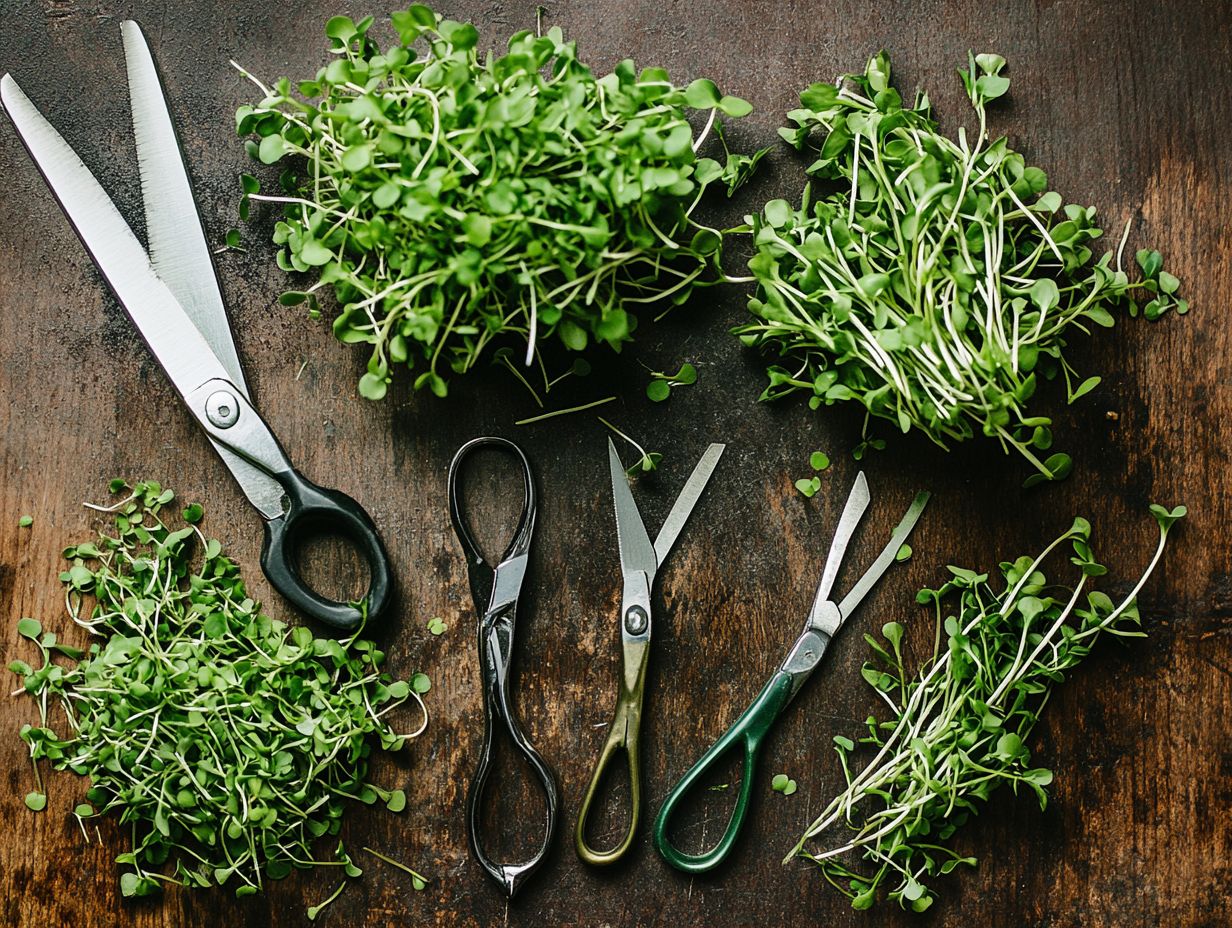
Mastering the proper techniques for using harvesting tools is crucial for maintaining the quality of your microgreens while streamlining the harvesting process. Employing correct cutting methods and optimal handling practices is vital to minimize damage and maximize your yield.
By understanding these techniques, you not only preserve the nutrient value of your greens but also enhance the overall experience, making it more enjoyable and rewarding.
Cutting and Handling Methods
Effective cutting and handling methods for microgreens are essential for ensuring your harvest is efficient and maintains the highest quality.
Timing your harvest is key! Cut at just the right moment; cutting too early or too late can significantly affect the flavor and nutrient density. Look for visual cues vibrant colors and the emergence of true leaves indicate the perfect moment for cutting.
Using sharp, clean scissors or knives is key to preventing damage to the stems, which minimizes the risk of wilting and post-harvest spoilage.
Once you ve harvested, store the microgreens in a cool, dark place to prolong their freshness, ensuring that the flavors and textures remain delightful until they make it to your plate.
By choosing the right tools and techniques, you ll enjoy a bountiful harvest of microgreens!
Maintaining and Cleaning Your Harvesting Tools
Maintaining and cleaning your harvesting tools is vital for ensuring their longevity and the hygiene of your microgreens. Proper care not only extends the life of your tools but also prevents contamination that could compromise the quality of your healthy vegetables.
By regularly cleaning and maintaining your harvesting supplies, you enhance the efficiency of your microgreens gardening experience, allowing you to cultivate with confidence and care. To ensure you’re getting the best results, check out this guide on how to harvest popular microgreen varieties.
Tips for Longevity and Sanitation
Using simple methods for the longevity and sanitation of your harvesting tools can significantly enhance your gardening experience while promoting robust plant growth. Regular inspections, proper cleaning techniques, and safe storage practices are essential for maintaining the quality of your tools.
By keeping your harvesting supplies hygienic, you help prevent diseases, ensuring your microgreens remain fresh and nutrient-dense.
You also help the environment by choosing eco-friendly supplies. For example, opting for biodegradable cleaning agents breaks down naturally without harming the environment, helping reduce pollution.
After using your harvesting tools, thoroughly wash them especially with a vinegar solution to eliminate harmful bacteria. Storing your tools in a dry, shaded area extends their lifespan and prevents rust, which is crucial for successful microgreen composting.
Keep your garden thriving with simple tool care! Regular maintenance fosters a healthier garden environment and leads to more abundant yields, enabling sustainable gardening that benefits both you and the planet.
Frequently Asked Questions
What are some best practices for using microgreen harvesting tools?
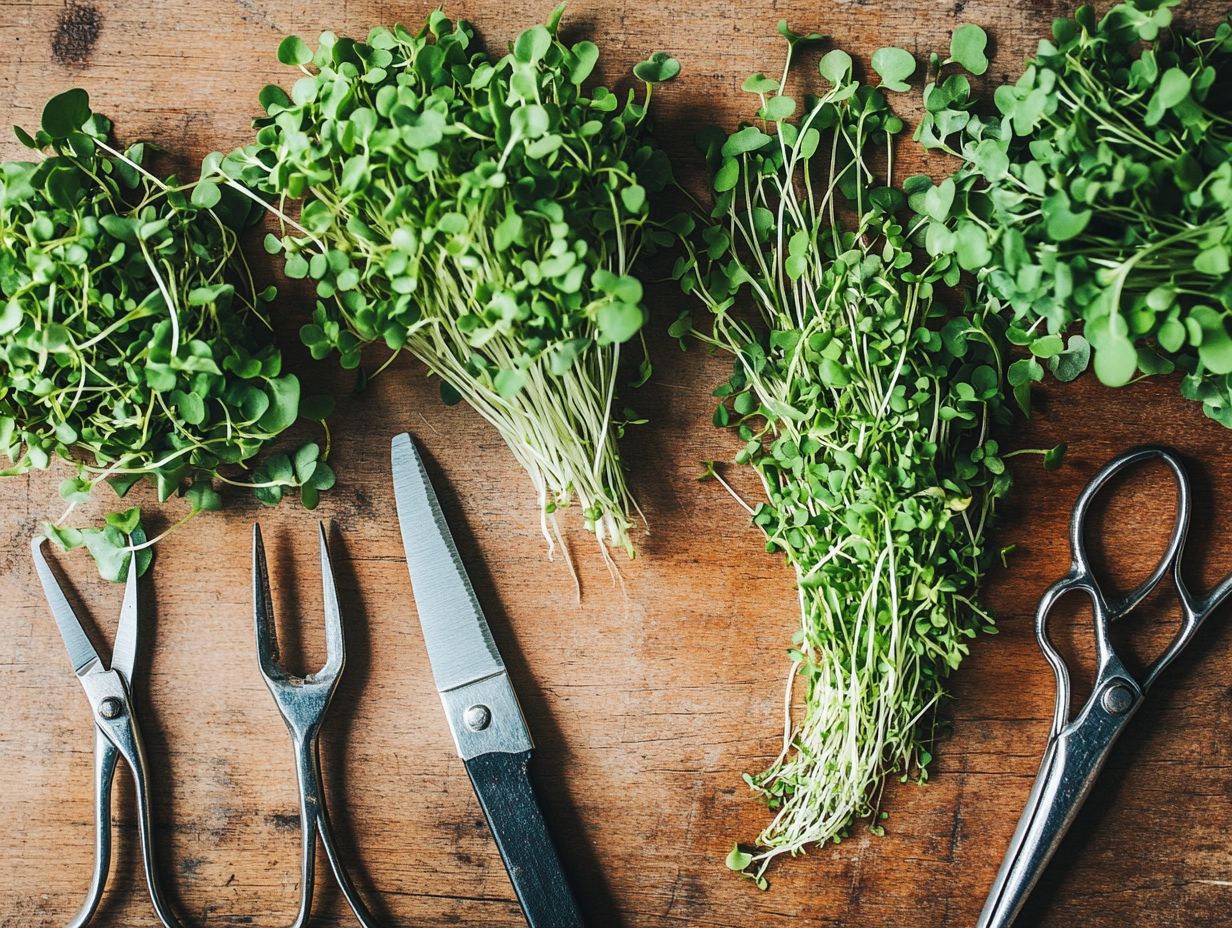
- Use clean and sharp blades.
- Sanitize the tools before and after each use.
- Handle the delicate microgreens gently.
Why is cleanliness crucial in microgreen harvesting?
Using clean and sharp blades ensures a clean cut, promoting healthy growth and reducing the risk of contamination. It also minimizes damage to the microgreens, resulting in a longer shelf life.
How often should I sanitize my microgreen harvesting tools?
We recommend sanitizing your tools before and after each use. This helps prevent the transfer of bacteria and other harmful pathogens between plants.
What are some ways to gently handle microgreens while harvesting?
To avoid damaging the delicate microgreens, handle them with care and avoid squeezing or pulling them forcefully. Using tools with a delicate touch and working slowly can also help prevent damage.
Can I reuse the same harvesting tools for different types of microgreens?
It is not recommended to use the same tools for different types of microgreens, as this can increase the risk of cross-contamination. It is best to have separate tools for each type of microgreen or to thoroughly sanitize them between uses.
Are there any alternative tools that can be used for harvesting microgreens?
While there are specific microgreen harvesting tools available, some alternatives include using scissors or sharp kitchen knives. Make sure these tools are clean and sharp before use to avoid damaging the microgreens.
Start caring for your tools today and watch your garden flourish!

